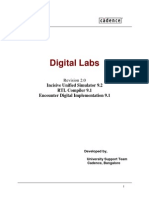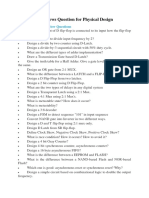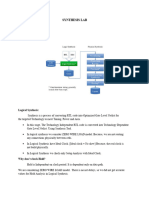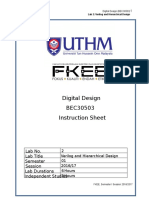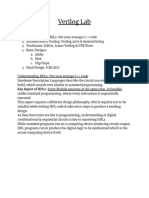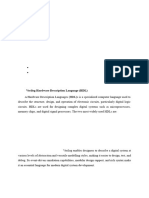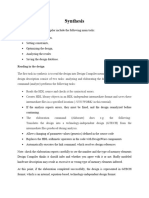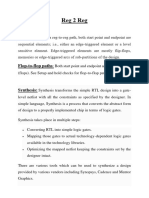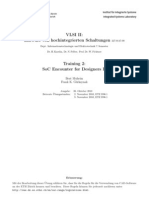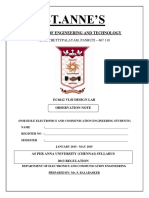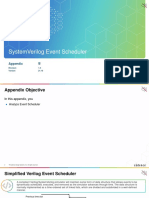Lab 2 - Behavioral Level, RTL, and Gate Level Design
Lab 2 - Behavioral Level, RTL, and Gate Level Design
Uploaded by
bschan86Copyright:
Available Formats
Lab 2 - Behavioral Level, RTL, and Gate Level Design
Lab 2 - Behavioral Level, RTL, and Gate Level Design
Uploaded by
bschan86Original Title
Copyright
Available Formats
Share this document
Did you find this document useful?
Is this content inappropriate?
Copyright:
Available Formats
Lab 2 - Behavioral Level, RTL, and Gate Level Design
Lab 2 - Behavioral Level, RTL, and Gate Level Design
Uploaded by
bschan86Copyright:
Available Formats
LAB 2 BEHAVIORAL LEVEL, RTL ,AND GATE LEVEL DESIGN
Overview In this lab student will learn the simple behavioural, Register Transfer Level and Gate level designs using ModelSim simulator. The first exercise will introduce the several levels of abstraction. Students then will simulate and analyse the circuit with different design levels. At the end of this lab, students must able to write a test-bench to simulate the design and able to identify the Verilog abstraction available. Objectives The objectives of this lab are: 1. To expose students with several levels of Verilog abstraction 2. To learn how to write a test-bench test a hardware design 3. To learn how to convert the Verilog coding to a circuit or otherwise. Part 1: Structural, Behavioral, RTL Design Ex 1.1 Structural design (Full Adder) 1. Create the structural adder file below in the text editor and save the files as addbit.v
2. Students are required to draw the 1 bit adder logic circuit. Understand the circuit and the HDL coding given above. 3. Create a test-bench file below and save the files as add_tst.v using text editor.
E&E Engineering, SKTM, UMS 2014
Page 1
4. Compile and simulate the Verilog HDL given according to the step in Part 1. 5. Select the suitable simulation running time. Analyze the waveform and re-simulate the hardware by adjusting the variable in the test-bench file. 6. Students are required to print-screen the waveform with the corresponding values for report purpose.
Ex 1.3 Behavioral design (Full Adder) 1. Create the behavioral adder file below in the text editor and save the files as addbit1.v
E&E Engineering, SKTM, UMS 2014
Page 2
2. Students are required to write a test-bench to simulate the behavioral adder design above. Save the file as add_tst1.v 3. Compile and simulate the Verilog HDL. Select the suitable simulation running time. Analyze the waveform.
Ex 1.3 RTL design (Full Adder) 1. Create the RTL adder file below in the text editor and save the files as addbit2.v
2. Students are required to write a test-bench to simulate the RTL adder design above. Save the file as add_tst2.v 3. Compile and simulate the Verilog HDL. Select the suitable simulation running time. Analyze the waveform.
Report 1. Access to E-Report System (ERS) at http://www.els.bugs3.com to submit online lab report before end of the lab. Please ask instructions from your lab demonstrator. 2. Your report must include the output/ waveform, test bench for Ex 1.2 and 1.3 and all related information that support your analysis. All the information MUST BE in SINGLE document. The extension file accept in the form is .doc / .docx / .pdf 3. All report submission must be on-time. Late submission will NOT BE accepted automatically.
References 1. ModelSim (v6.5b) Tutorial Chapter 3 to 6 2. Microelectronics Lecture Note
E&E Engineering, SKTM, UMS 2014
Page 3
You might also like
- Tessent MemoryBIST RTL FlowDocument35 pagesTessent MemoryBIST RTL Flowpravallika vysyaraju100% (1)
- Digital Lab Manual Cadence PDFDocument82 pagesDigital Lab Manual Cadence PDFLokesh Nikhade100% (1)
- Interviews Question For Physical Design: Digital Design Interview QuestionsDocument44 pagesInterviews Question For Physical Design: Digital Design Interview QuestionsPavan Raj100% (1)
- Design of Very Large Scale Integration CircuitsDocument30 pagesDesign of Very Large Scale Integration CircuitsStudentNo ratings yet
- VSCode Activity#3Document19 pagesVSCode Activity#3cedricktfesalbon12No ratings yet
- Rptoptop GopiDocument21 pagesRptoptop Gopigaddamprathyusha55No ratings yet
- Topic: Synthesis Design FlowDocument9 pagesTopic: Synthesis Design FlowReddaiah YedotiNo ratings yet
- University of Hawaii Department of Electrical Engineering EE 361L Digital Systems and Computer Design Laboratory Timing SimulationDocument6 pagesUniversity of Hawaii Department of Electrical Engineering EE 361L Digital Systems and Computer Design Laboratory Timing SimulationBhai BaiNo ratings yet
- RTL2 Sil 6Document30 pagesRTL2 Sil 6Vinay ChandruNo ratings yet
- Digital Design BEC30503 Instruction Sheet: Lab No. Lab Title Semester Session Lab Durations Independent StudiesDocument30 pagesDigital Design BEC30503 Instruction Sheet: Lab No. Lab Title Semester Session Lab Durations Independent StudiesKarti ViveygenNo ratings yet
- Logic Synthesis 1 PavanKVDocument80 pagesLogic Synthesis 1 PavanKVdk13071987100% (1)
- VLSI and OFC Lab2016 PDFDocument63 pagesVLSI and OFC Lab2016 PDFsandeep_hriturajNo ratings yet
- Project ReportDocument13 pagesProject Reportf20200837No ratings yet
- Quartus II Tutorial HDLDocument11 pagesQuartus II Tutorial HDLssunil7432No ratings yet
- Verilog Lab RDDDocument5 pagesVerilog Lab RDDOjaseeDubleNo ratings yet
- Lab 2 Introduction To VHDL September 15, 2012: Eng. Asma ObeidDocument8 pagesLab 2 Introduction To VHDL September 15, 2012: Eng. Asma ObeidJawath BinaNo ratings yet
- Experiment 10 - Half-Adder Using Verilog Devices and Digital ICDocument10 pagesExperiment 10 - Half-Adder Using Verilog Devices and Digital ICleninvalentine97No ratings yet
- Lab 3 (Verilog Implementation of Stop Light Controller)Document7 pagesLab 3 (Verilog Implementation of Stop Light Controller)Muhtasim Fuad JeetNo ratings yet
- CS 152 Laboratory Exercise 1 (Directed Portion Only) : 1 Introduction and GoalsDocument15 pagesCS 152 Laboratory Exercise 1 (Directed Portion Only) : 1 Introduction and GoalsVinay PrasanthNo ratings yet
- Lab 3 Introduction To VerilogDocument6 pagesLab 3 Introduction To Verilogpioneer boysNo ratings yet
- HDL Le Unite 4Document75 pagesHDL Le Unite 4bhishma.ec22No ratings yet
- EE 330 Lab 12 Fall 2019Document23 pagesEE 330 Lab 12 Fall 2019Nguyen Van ToanNo ratings yet
- BEC7L1 - Digital Cmos Vlsi-LabDocument66 pagesBEC7L1 - Digital Cmos Vlsi-LabRamkumardevendiranDevenNo ratings yet
- Lab 1Document5 pagesLab 1tttm2609No ratings yet
- Verilogxl TutDocument68 pagesVerilogxl TutPrak AshNo ratings yet
- RTL To GDSDocument70 pagesRTL To GDSinucummNo ratings yet
- Lab 3Document2 pagesLab 3Satayish AnjumNo ratings yet
- Reg 2 RegDocument7 pagesReg 2 RegDINESH VINUKONDANo ratings yet
- VerilogDocument3 pagesVerilograzanyasin810No ratings yet
- VHDL Lab 2Document8 pagesVHDL Lab 2Abdul RajakNo ratings yet
- Lab8 2-Bit Binary Adder-SubtractorDocument5 pagesLab8 2-Bit Binary Adder-SubtractorMazoon ButtNo ratings yet
- Artix7 Verilog Word FileDocument7 pagesArtix7 Verilog Word FileSwapna SarkerNo ratings yet
- Assignment 1Document4 pagesAssignment 1Hadia AndarNo ratings yet
- EC8661-VLSI DESIGN LAB-116516724-Vlsi Lab ManualDocument149 pagesEC8661-VLSI DESIGN LAB-116516724-Vlsi Lab ManualAngelin ArulNo ratings yet
- LAB#4Document3 pagesLAB#4Unsa Jan Abdul QayyumNo ratings yet
- Training 2Document44 pagesTraining 2Baluvu Jagadish100% (1)
- Lab2 Synopsys DCDocument12 pagesLab2 Synopsys DCkrunalNo ratings yet
- Assignments System Programming in CDocument23 pagesAssignments System Programming in CakrimetchNo ratings yet
- Verilog-2001 Behavioral and Synthesis Enhancements: Revised - April 2002Document23 pagesVerilog-2001 Behavioral and Synthesis Enhancements: Revised - April 2002Nahyan Chowdhury TamalNo ratings yet
- ESD528 Assignmnet-PT08-1Document5 pagesESD528 Assignmnet-PT08-1nyjilgeorge1No ratings yet
- EC6612 VLSI Design LabDocument130 pagesEC6612 VLSI Design LabbalabaskerNo ratings yet
- Lab 10Document5 pagesLab 10mhussain.bee23seecsNo ratings yet
- EE3022-Vlsi Lab ManualDocument142 pagesEE3022-Vlsi Lab Manualkingqwe123003No ratings yet
- Experiment No. 1 TANNER IC WORK FLOW Using "S-EDIT" 1. Objective(s)Document6 pagesExperiment No. 1 TANNER IC WORK FLOW Using "S-EDIT" 1. Objective(s)jb bascoNo ratings yet
- EC8661-VLSI DESIGN LAB-116516724-vlsi Lab Manual PDFDocument146 pagesEC8661-VLSI DESIGN LAB-116516724-vlsi Lab Manual PDFSathish Kumar G Assistant Professor ECE KingstonNo ratings yet
- Code Review Exercise WorkbookDocument15 pagesCode Review Exercise WorkbookSidnary LuengasNo ratings yet
- Vlsi Lab7 F 13 V1Document9 pagesVlsi Lab7 F 13 V1Shannan WeberNo ratings yet
- 1 XxvayfefDocument3 pages1 XxvayfefRavi Kiran ReddyNo ratings yet
- HDL Programming Lab Manual Final UpdatedDocument77 pagesHDL Programming Lab Manual Final UpdateddeepaNo ratings yet
- Lab-Manual Batch 2018Document116 pagesLab-Manual Batch 2018R kNo ratings yet
- Tutorial For Design Compiler: Shell PromptDocument7 pagesTutorial For Design Compiler: Shell Promptsudhakar kandiNo ratings yet
- Faculty of Engineering: Lab SheetDocument3 pagesFaculty of Engineering: Lab SheetThamilarasan RamalingamNo ratings yet
- Birla Institute of Technology & Science, Pilani Lab Sheet - 1Document7 pagesBirla Institute of Technology & Science, Pilani Lab Sheet - 1SATYAVRAT SHARMANo ratings yet
- Training 3Document17 pagesTraining 3Thomas George100% (1)
- Introduction To VerilogDocument7 pagesIntroduction To VerilogabduljabaarNo ratings yet
- Lab 1 Spring 13Document3 pagesLab 1 Spring 13Kumaraguru RauNo ratings yet
- Digital Lab Manual New PDFDocument76 pagesDigital Lab Manual New PDFvmspraneethNo ratings yet
- Lab Manual CAODocument4 pagesLab Manual CAOkingraajaNo ratings yet
- Python Advanced Programming: The Guide to Learn Python Programming. Reference with Exercises and Samples About Dynamical Programming, Multithreading, Multiprocessing, Debugging, Testing and MoreFrom EverandPython Advanced Programming: The Guide to Learn Python Programming. Reference with Exercises and Samples About Dynamical Programming, Multithreading, Multiprocessing, Debugging, Testing and MoreNo ratings yet
- Combinational CircuitsDocument68 pagesCombinational Circuitsavita207No ratings yet
- Convolution Encoder Verilog CodeDocument3 pagesConvolution Encoder Verilog CodeMounesh Panchal50% (4)
- Mentor Graphics Modelsim SE 10.1c - RuTracker - Org (Ex TorrentsDocument5 pagesMentor Graphics Modelsim SE 10.1c - RuTracker - Org (Ex Torrentstsk4b7No ratings yet
- System Verilog Introduction, Data TypesDocument52 pagesSystem Verilog Introduction, Data TypesSrinivas AluvalaNo ratings yet
- EE292A Lecture 4.verificationDocument31 pagesEE292A Lecture 4.verificationwuxiangjin08No ratings yet
- Lab 5Document4 pagesLab 5petermurtarghNo ratings yet
- Synthesis and LayoutDocument8 pagesSynthesis and LayoutMallappa PatilNo ratings yet
- FPGA DesignDocument19 pagesFPGA DesignDana HowellNo ratings yet
- EEE3342 - Lab ManualDocument136 pagesEEE3342 - Lab ManualOlivier QuevillonNo ratings yet
- Eee646 Fpga-based-system-Design Ela 2.00 Ac29Document2 pagesEee646 Fpga-based-system-Design Ela 2.00 Ac29Ranjith M KumarNo ratings yet
- Verilog Code Digital ClockDocument10 pagesVerilog Code Digital ClockTalat KhAnNo ratings yet
- Cmos Vlsi Design Lab 2: Datapath Design and Verification: I. Verilog Model RTL SimulationDocument8 pagesCmos Vlsi Design Lab 2: Datapath Design and Verification: I. Verilog Model RTL Simulationhello24023No ratings yet
- Dd&co-Bcs302-First Test Question BankDocument3 pagesDd&co-Bcs302-First Test Question BankRonita JoeNo ratings yet
- System Verilog Material - FinalDocument285 pagesSystem Verilog Material - FinalEvancy Grace N100% (3)
- List of Vlsi Based CompaniesDocument22 pagesList of Vlsi Based CompaniesSheetal Chennapnoor100% (2)
- Low Power Digital VLSI DesignDocument60 pagesLow Power Digital VLSI Designraymond irudayarajNo ratings yet
- SPR 19 ResumeDocument1 pageSPR 19 Resumeapi-482184757No ratings yet
- Lec4 Slides TestbenchesDocument30 pagesLec4 Slides TestbenchesAbdalrhman juberNo ratings yet
- Lecture07 Full and ParallelDocument45 pagesLecture07 Full and ParallelVeadeshNo ratings yet
- SystemC Questa TutorialDocument11 pagesSystemC Questa TutorialmanavalaNo ratings yet
- Identify ME H-2013.03M-SP1 User Guide PDFDocument214 pagesIdentify ME H-2013.03M-SP1 User Guide PDFParjanya Sai Krishna YellapragadaNo ratings yet
- College Brochure - Cranes VarsityDocument4 pagesCollege Brochure - Cranes Varsityrvs guruNo ratings yet
- 01-Verilog Introduction-MergedDocument82 pages01-Verilog Introduction-MergedqwertyNo ratings yet
- GS EE271 S10 LeDocument7 pagesGS EE271 S10 LeravindarsinghNo ratings yet
- Digital VLSI DesignDocument15 pagesDigital VLSI DesignSrivyshnavi TangellapelliNo ratings yet
- AppendixB SysVlogDesVer 21 10Document4 pagesAppendixB SysVlogDesVer 21 10MagNo ratings yet
- Siemens Eda - Technical Paper - The Missing Link The Testbench To Dut ConnectionDocument14 pagesSiemens Eda - Technical Paper - The Missing Link The Testbench To Dut Connectionsrjadhav248No ratings yet
- DSDV Module-4Document10 pagesDSDV Module-4BOBAN05No ratings yet
- Unit 5 Verilog HDL Topic 1 &2 Basics of The VERILOG LanguageDocument8 pagesUnit 5 Verilog HDL Topic 1 &2 Basics of The VERILOG LanguageECE TheivanayakiNo ratings yet

